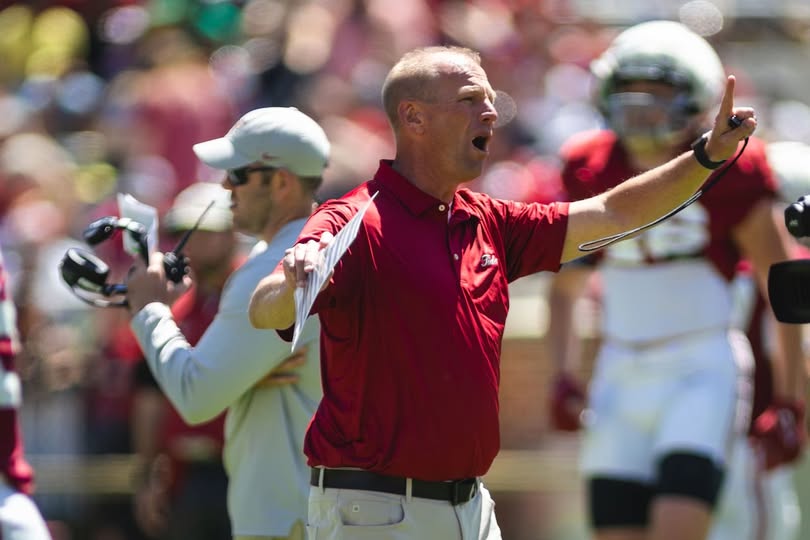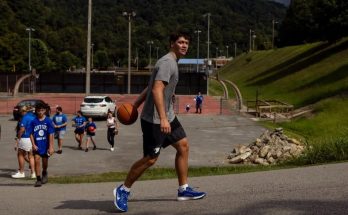5 Burning Questions for Alabama Football After Spring Practice
As the dust settles from Alabama football’s spring practices, the landscape in Tuscaloosa remains both familiar and foreign. The Crimson Tide—still loaded with elite talent and lofty expectations—are navigating their first full offseason under head coach Kalen DeBoer. Gone is the legendary Nick Saban, taking with him an era defined by dominance. In its place, a new chapter is being written, one that will ultimately be judged by how quickly Alabama can maintain its place atop the college football mountain.
Spring practice brought answers, but it also unearthed a fresh set of uncertainties. The Tide are evolving under a new coaching staff with a unique offensive identity and schematic changes on both sides of the ball. But while the Crimson Tide’s ceiling remains as high as ever, the road to the College Football Playoff is lined with questions.
Here are five burning questions Alabama fans and college football pundits alike are asking after spring practice:
1. Is Jalen Milroe the clear-cut starter, or is there a real QB competition brewing?
Jalen Milroe’s emergence during the 2023 season was nothing short of electric. His dual-threat capabilities turned the tide—pun intended—of Alabama’s season, culminating in an SEC Championship win over Georgia. Milroe’s legs saved drives. His deep ball made defenses pay. But questions about his consistency, decision-making, and fit in DeBoer’s more timing-oriented passing scheme remain.
During spring practice, Milroe took the majority of first-team reps, but he was not immune to criticism. Reports out of Tuscaloosa suggested that while his raw talent is unmatched, the transition to offensive coordinator Nick Sheridan’s more West Coast-style attack has been bumpy at times. Sheridan, who followed DeBoer from Washington, emphasizes quick reads and rhythm passing—areas Milroe hasn’t mastered yet.
Meanwhile, redshirt sophomore Ty Simpson and freshman phenom Julian Sayin each made their case during the A-Day spring game. Simpson looked sharper in the short-to-intermediate game and has reportedly made strides in understanding the new offense. Sayin, on the other hand, showed poise beyond his years, earning praise for his footwork and mechanics.
Still, Milroe enters summer workouts as the presumed starter. But unlike last year, he won’t have the benefit of a long leash. DeBoer has made it clear that competition is key. If Milroe struggles early, don’t be surprised if Alabama gives someone else a shot—especially if the Tide’s offense starts slow out of the gate.
2. Can the offensive line become a dominant force again?
For decades, Alabama football has prided itself on punishing offensive lines. The 2023 unit showed flashes of brilliance but lacked consistency, particularly in pass protection. Left tackle Kadyn Proctor’s surprising transfer to Iowa left a massive hole—literally and figuratively—on the blind side, forcing DeBoer and offensive line coach Chris Kapilovic to rethink their starting five.
The early reviews from spring are cautiously optimistic. Redshirt freshman Wilkin Formby has stepped into the left tackle role and received high marks for his size (6’8”, 315 pounds) and footwork. He still needs experience, but his ceiling is high. On the right side, Elijah Pritchett seems to have locked down the tackle spot after a strong camp.
Interior linemen Tyler Booker and Jaeden Roberts are returning, providing both power and leadership. Center James Brockermeyer has improved his command of the line calls, a critical development given the changes to the offensive scheme.
Still, depth is a concern. Injuries during the spring exposed just how thin Alabama is behind the starters. The offensive line doesn’t need to be perfect, but for the Tide to reach their potential—especially in a conference where defensive fronts like LSU, Georgia, and Texas loom—they need to be tougher, smarter, and more cohesive.
3. Will the wide receiver corps become elite again?
Gone are the days of Alabama trotting out a receiving corps featuring names like DeVonta Smith, Jaylen Waddle, and Jerry Jeudy. While last year’s group improved as the season went on, inconsistency plagued the unit. Drops, lack of separation, and timing issues were persistent problems.
Enter DeBoer and his staff, who bring with them a proven track record of maximizing receiver talent. Rome Odunze, Jalen McMillan, and Ja’Lynn Polk each thrived under this system at Washington. Now, it’s up to Alabama’s current stable to elevate their play.
The standout of the spring has been sophomore Kendrick Law, whose route-running and explosiveness earned rave reviews. Law looks poised to be the go-to guy, especially on third downs. Meanwhile, Isaiah Bond remains a dangerous deep threat, and his chemistry with Milroe continues to improve.
True freshman Ryan Williams—the five-star early enrollee who flipped from Auburn—has drawn comparisons to Amari Cooper with his smooth strides and elite hands. While he’s still adjusting to the college game, the hype surrounding him is very real. Junior Ja’Corey Brooks, back from injury, provides veteran experience and size on the outside.
The group is more talented than last season, but their development is critical to Alabama’s offensive success. If Sheridan’s system works as advertised, this could be the year Alabama returns to being “Wide Receiver U.”
4. Can the defense maintain its elite standard under Kane Wommack?
With Kevin Steele retiring and defensive backs coach Travaris Robinson departing for Georgia, Kalen DeBoer turned to Kane Wommack as Alabama’s new defensive coordinator. Wommack, a former head coach at South Alabama, brings a more aggressive, attacking philosophy to the defense—something Tide fans are eager to see.
The centerpiece of the defense remains linebacker Deontae Lawson, who returned for another season despite NFL interest. Lawson will anchor the middle of the field, but he’s surrounded by a mix of veterans and rising stars. Jihaad Campbell had a strong spring and looks ready to take the next step alongside Lawson.
On the edge, sophomore Keon Keeley has been nearly unblockable. After a quiet freshman year, the former five-star has transformed into a havoc-wreaking presence this spring. If he continues on this trajectory, Alabama may once again boast one of the SEC’s top pass rushes.
In the secondary, cornerbacks Kool-Aid McKinstry and Terrion Arnold are gone, creating major holes. The battle for cornerback spots is ongoing, with redshirt sophomore Earl Little Jr. and freshman Zabien Brown making waves in spring ball. At safety, Malachi Moore’s return gives the Tide an experienced leader in the back end.
The question isn’t talent—it’s about cohesion and buy-in. Wommack’s system is predicated on trust, communication, and aggression. If Alabama adapts quickly, the defense could be just as dominant as in the Saban era. But if there’s a learning curve, opponents like Georgia and Tennessee could exploit growing pains.
5. How quickly can Kalen DeBoer establish his culture?
For all the schematic changes, position battles, and recruiting updates, one overarching question hovers above everything: can Kalen DeBoer truly build his version of Alabama football?
Following a legend like Nick Saban is perhaps the most daunting task in all of sports. DeBoer’s track record is impressive—he led Washington to a national title game appearance and built winning programs at multiple stops—but Alabama is different. The expectations aren’t just high; they’re unforgiving.
Spring practice gave fans a first look at DeBoer’s approach. Practices were reportedly more upbeat and player-driven. He’s empowered his assistants to take ownership of their units and has fostered a strong culture of accountability without fear. Several players have spoken publicly about how “fresh” the environment feels.
But culture takes time. Spring was a starting point, not a destination. How DeBoer handles adversity—the first loss, the first controversy, the first major injury—will tell us more about his readiness than any scrimmage.
He’s also juggling a delicate balancing act: respecting the legacy of Saban while putting his own stamp on the program. It’s a transition the players seem to be buying into, but success in the fall will determine whether that belief solidifies or falters.
Final Thoughts
Alabama football is entering uncharted waters. The program remains a titan, but for the first time in 17 years, it’s doing so without Nick Saban at the helm. Spring practice provided a glimpse into the new era under Kalen DeBoer—a mix of continuity and change, of promise and potential pitfalls.
The quarterback room is talented but unproven in this new offense. The offensive line and receivers are loaded with raw ability but need to gel fast. The defense, while stacked with future pros, is adjusting to a new philosophy. And through it all, DeBoer is tasked with guiding a tradition-rich program through its most significant transition in modern history.
The good news for Alabama fans? The foundation remains elite. The talent pipeline is intact. And if DeBoer’s spring blueprint is any indication, the Crimson Tide are not going anywhere.
But make no mistake—the questions are real. And how Alabama answers them will define the 2025 season.



